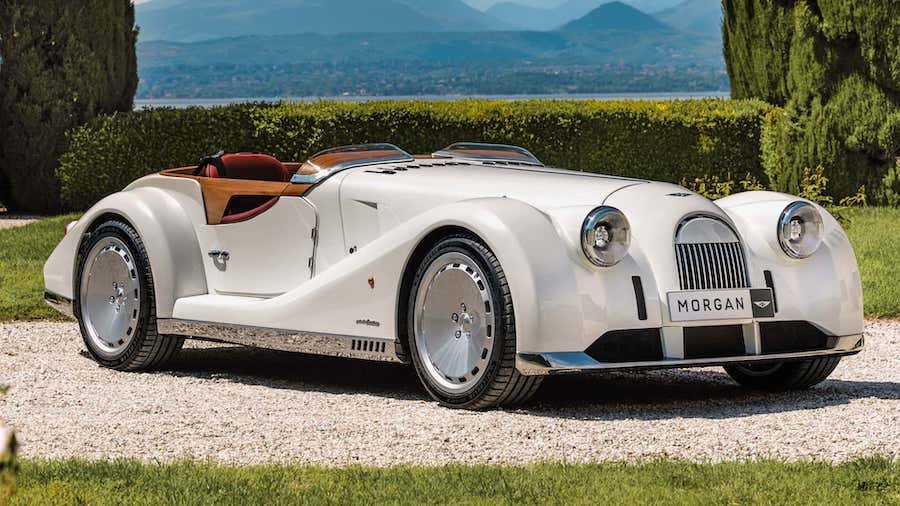Morgan and Pininfarina have unveiled an exclusive barchetta-bodied, two-seat sports car called the Midsummer.
Based on the underpinnings of Morgan’s existing Plus Six model, it is clad with a magnificent new hand-formed body on which both Pininfarina's and Morgan's design teams have cooperated.
The two partners say the car is a celebration of their combined 200 years of coachbuilding expertise. It is named after Midsummer Hill, which forms part of the Malvern Hills that tower above the Pickersleigh Road factory, where Morgan has been hand-building its cars since 1914. The Midsummer’s production will be limited to 50 units, which have already been sold to well-heeled supporters and friends of the marque.
Costing around £200,000, depending on the exact specifications laid down by owners, the Midsummer is powered by the same BMW-supplied 335bhp straight six as the standard car and is expected to broadly match its performance credentials: 0-62mph in 4.2sec and a top speed of 166mph.
The batch of 50 cars will run through Morgan’s existing production process for its Plus models and finish in the early months of 2025. Though the batch is small, Morgan CEO Massimo Fumarola said it adds emphasis to the company’s wider desire to create a series of limited-run specials, an initiative it launched with the Morgan CX-T – the “overland adventure” model – nearly three years ago.
Pininfarina and Morgan are extremely keen to emphasise the role of traditional coachbuilding skills in the Midsummer: many owners have already visited the Malvern Link works to view the prototype, holding one-to-one consultations with designers – including chief design officer Jonathan Wells, who has led the two-year project – to decide their cars’ exact equipment, colour and trim specifications.
The car even carries a unique version of the revered body-side badge that reads ‘Pininfarina Fuoroserie’, which indicates that the design is unique, and ‘out of series’.
While the Midsummer’s relationship with existing Morgans is very clear, almost every detail on the surface has been rethought or redeveloped.
The most eye-grabbing change is the generous use of beautifully sculpted laminated teak mouldings that surround the cockpit and provide the car with a distinct interior character and a new exterior profile. Creating the teak laminates, whose individual sheets can run to 120 layers no more than 0.6mm thick, takes 30 hours just on its own.
As a cruising sports car rather than a performance chaser, the Midsummer does without the usual Morgan flat windscreen, replacing that with a pair of lower, more subtle aero screens. The fascia and instruments resemble Morgan originals, but the Midsummer’s unique design adds a number of intricate new details.
Outside, everything is recognisable, but different. The round headlights are larger and now incorporate both the indicators and the daytime-running lights, while the rear lights – made exclusively for Morgan – are also simplified. The radiator has an aero-cheating shroud, reminiscent of past Morgan racing cars, and the long bonnet gains horizontal air extraction louvres redesigned by Pininfarina. The aluminium front wings are subtly reshaped to carry the larger lights, as well as to progress the design.
In particular, they are fuller behind the front wheels, which gives a more purposeful stance and improves aero.
The rear wings also have a chamfer on their leading surface for aero reasons and there’s even a subtle diffuser under the car’s rear to counter lift at speed. Hand-formed stainless steel finishers along the sills add to the coachbuilt class. And the uniquely designed wheels are one of the most effective of a suite of weight-saving measures designed to keep dry weight under 1000kg.
For most people, the Midsummer’s crowning glory is its elegant barchetta tail, which elongates the car (again to the benefit of aero) and perfectly blends Morgan’s unmistakable frontal features with a rear style reminiscent of some of Pininfarinas’s greatest cars.
This harmonises perfectly with Morgan’s already stated aim of eventually moving the look of some production models forward a decade or two.
“I’m most pleased with the Midsummer’s rear three-quarter proportions and how the car sits, thanks to obsessive attention to detail to refine the wheel- to-body relationship,” said Wells. “Midsummer establishes design foundations we can build upon for future Morgan models.
How the Morgan Midsummer came about
According to Pininfarina’s chief creative officer, Felix Kilbertus, the Midsummer project grew out of what he calls an “immersive” journey between the two brands. It began with a ‘what if?’ session involving the two firms’ design teams in an English pub and progressed to more specific discussions in Italy over very good coffee – with lots of collaboration sessions in between.
Morgan design chief Jonathan Wells says the Italian firm’s young designers, used to working with the latest digital tools in a large community, “really enjoyed seeing how directly we at Morgan can interact with the people who are making the cars in the factory nearby.
“It was pretty awesome for us to see their digital stuff – their power walls and VR suites. We started discussing whether there was a project we could do together. We were looking for something to provide a bit of a bang, a decent change of direction. Midsummer is what came up.



Related News

